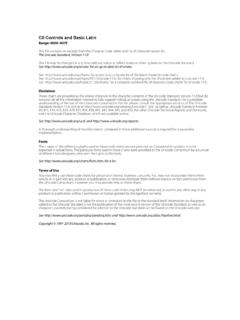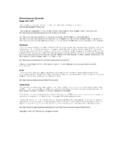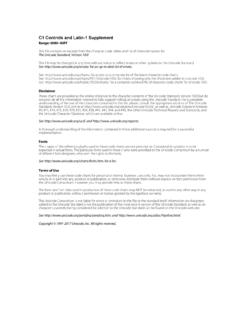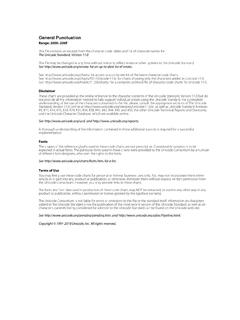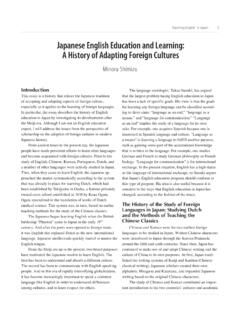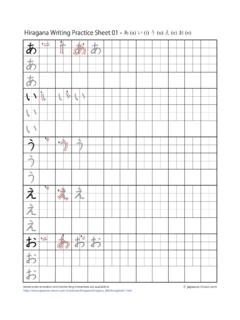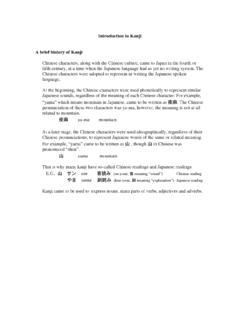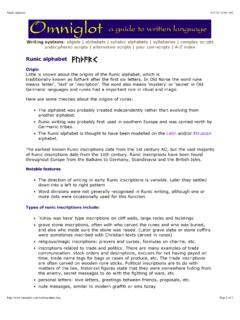Transcription of Unicode Character Database Dai Kan-Wa Jiten Library of ...
1 This PDF file is an excerpt from The Unicode Standard, Version , issued by the Unicode Consor-tium and published by Addison-Wesley. The material has been modified slightly for this online edi-tion, however the PDF files have not been modified to reflect the corrections found on the Updatesand Errata page ( ). For information on more recent versions of thestandard, see of the designations used by manufacturers and sellers to distinguish their products are claimedas trademarks. Where those designations appear in this book, and Addison-Wesley was aware of atrademark claim, the designations have been printed in initial capital letters. However, not all wordsin initial capital letters are trademark Unicode Consortium is a registered trademark, and Unicode is a trademark of Unicode , Unicode logo is a trademark of Unicode , Inc.
2 , and may be registered in some jurisdictions. The authors and publisher have taken care in preparation of this book, but make no expressed orimplied warranty of any kind and assume no responsibility for errors or omissions. No liability isassumed for incidental or consequential damages in connection with or arising out of the use of theinformation or programs contained Unicode Character Database and other files are provided as-is by Unicode , Inc. No claims aremade as to fitness for any particular purpose. No warranties of any kind are expressed or implied. Therecipient agrees to determine applicability of information Kan-Wa Jiten used as the source of reference Kanji codes was written by Tetsuji Morohashi andpublished by Taishukan and CD-ROM label design: Steve Mehallo, publisher offers discounts on this book when ordered in quantity for bulk purchases and specialsales.
3 For more information, customers in the please contact Corporate and GovernmentSales, (800) 382-3419, For sales outside of the , please contactInternational Sales, +1 317 581 3793, Addison-Wesley on the Web: of Congress Cataloging-in-Publication DataThe Unicode Standard, Version : the Unicode Consortium /Joan [et al.]. p. cm. Includes bibliographical references and index. ISBN 0-321-18578-1 (alk. paper) 1. Unicode (Computer Character set). I. Aliprand, Joan. 2004 2 dc212003052158 Copyright 1991 2003 by Unicode , rights reserved. No part of this publication may be reproduced, stored in a retrieval system, ortransmitted in any form or by any means, electronic, mechanical, photocopying, recording or other-wise, without the prior written permission of the publisher or Unicode , Inc.
4 Printed in the UnitedStates of America. Published simultaneously in information on obtaining permission for use of material from this work, please submit a writtenrequest to the Unicode Consortium, Post Office Box 39146, Mountain View, CA 94039-1476, USA,Fax +1 650 693 3010 or to Pearson Education, Inc., Rights and Contracts Department, 75 ArlingtonStreet, Suite 300 Boston, MA 02116, USA, Fax: +1 617 848 0-321-18578-1 Text printed on recycled paper1 2 3 4 5 6 7 8 9 10 CRW 0706050403 First printing, August 2003 The Unicode Standard Aug 03291 Chapter 11 East Asian Scripts11 This chapter presents the following scripts: Han Bopomofo Hiragana katakana Hangul YiThe characters that are now called East Asian ideographs, and known as Han Ideographs inthe Unicode Standard, were developed in China in the second millennium.
5 The basicsystem of writing Chinese using ideographs has not changed since that time, although theset of ideographs used, their specific shapes, and the technologies involved have developedover the centuries. The encoding of Chinese ideographs in the Unicode Standard isdescribed in Section , civilizations developed surrounding China, they frequently adapted China s ideographsfor writing their own languages. Japan, Korea, and Vietnam all borrowed and modifiedChinese ideographs for their own languages. Chinese is an isolating language, monosyl-labic and noninflecting, and ideographic writing suits it well, but as Han ideographs wereadopted for unrelated languages, extensive modifications were Chinese ideographs were originally used to write Japanese, for which they are, in fact,ill suited.
6 As an adaptation, the Japanese developed two syllabaries, hiragana and katakana ,whose shapes are simplified or stylized versions of certain ideographs. (See Section ,Hiragana and katakana .) Chinese ideographs are called kanji in Japanese and are still used,in combination with hiragana and katakana , in modern Korea, Chinese ideographs were originally used to write Korean, for which they are alsoill suited. The Koreans developed an alphabetic system, Hangul, discussed in Section ,Hangul. The shapes of Hangul syllables or the letter-like jamos of which they are comprisedare not directly influenced by Chinese ideographs. However, the individual jamos aregrouped into syllabic blocks that resemble ideographs both visually and in the relationshipthey have to the spoken language (one syllable per block).
7 Chinese ideographs are calledhanja in Korean and are still used together with hangul in South Korea for modern Unicode Standard includes a complete set of Korean Hangul syllables, as well as theindividual jamos, which can also be used to write Korean. Section , Conjoining JamoBehavior, describes how to use the conjoining jamos and how to convert between the twomethods for representing Vietnam, a set of native ideographs was created for Vietnamese based on the same prin-ciples used to create new ideographs for Chinese. These Vietnamese ideographs were usedEast Asian Scripts292 8 Aug 03 The Unicode Standard the beginning of the twentieth century and are still occasionally used in morerecent signage and other limited was originally written using a set of ideographs invented in imitation of the Yi as encoded in the Unicode Standard is a syllabary derived from these ideo-graphs and is discussed in Section , , discussed in Section , Bopomofo, is another recently invented syllabic system,used to represent Chinese all these East Asian scripts, the characters (Chinese ideographs, Japanese kana, KoreanHangul syllables, and Yi syllables)
8 Are written within uniformly sized rectangles, usuallysquares. Traditionally, the basic writing direction followed the conventions of Chinesehandwriting, in top-down vertical lines running right-to-left across the page. Under theinfluence of Western printing technologies, a horizontal, left-to-right directionality hasbecome common, and proportional fonts are seeing increased use, particularly in , right-to-left text is also found on occasion, usually for shorter texts such asinscriptions or store signs. Diacritical marks are rarely used, although phonetic annota-tions are not uncommon. Older editions of the Chinese classics sometimes use the ideo-graphic tone marks (U+ +302D) to indicate unusual pronunciations of older Character sets include characters intended to simplify the implementation ofEast Asian scripts, such as variant punctuation forms for text written vertically, halfwidthforms (which occupy only half a rectangle), and fullwidth forms (which allow Latin lettersto occupy a full rectangle).
9 These characters are included in the Unicode Standard for com-patibility with older A, Han Unification History, describes how the diverse typographic traditions ofmainland China, Taiwan, Japan, Korea, and Vietnam have been reconciled to provide acommon set of ideographs in the Unicode Standard for all these languages and Asian Unicode Standard Aug HanCJK Unified IdeographsThe three blocks of CJK unified ideographs contain a set of unified Han ideographic char-acters used in the written Chinese, Japanese, and Korean The term Han,derived from the Chinese Han Dynasty, refers generally to Chinese traditional culture. TheHan ideographic characters make up a coherent script, which was traditionally written ver-tically, with the vertical lines ordered from right to left.
10 In modern usage, especially in tech-nical works and in computer-rendered text, the Han script is written horizontally from leftto right and is freely mixed with Latin or other scripts. When used in writing Japanese orKorean, the Han characters are interspersed with other scripts unique to those languages(Hiragana and katakana for Japanese; Hangul syllables for Korean).The term Han ideographic characters is used within the Unicode Standard as a commonterm traditionally used in Western texts, although sinogram is preferred by professionallinguists. Taken literally, the word ideograph applies only to some of the ancient originalcharacter forms, which indeed arose as ideographic depictions. The vast majority of Hancharacters were developed later via composition, borrowing, and other non-ideographicprinciples, but the term Han ideographs remains in English usage as a conventional coverterm for the script as a Han ideographic characters constitute a very large set, numbering in the tens of thou-sands.
